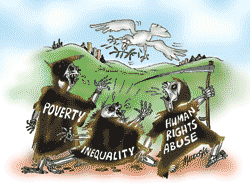 There were few tourists, but a recent flight out of Kathmandu was full. The back of the plane was packed with a hundred Nepali workers off to Malaysia-most had sold their land to afford the ticket and fees of labour dalals euphemistically called "manpower agents". The middle of the plane had a boisterous group of a dozen senior civil servants of His Majesty's Government off for a two-week administration and management training of senior executives. And right in front was the Nepali delegation headed for a follow-up to the World Food Summit in Rome.
There were few tourists, but a recent flight out of Kathmandu was full. The back of the plane was packed with a hundred Nepali workers off to Malaysia-most had sold their land to afford the ticket and fees of labour dalals euphemistically called "manpower agents". The middle of the plane had a boisterous group of a dozen senior civil servants of His Majesty's Government off for a two-week administration and management training of senior executives. And right in front was the Nepali delegation headed for a follow-up to the World Food Summit in Rome. There you had it: three classes of Nepali society (first, business and economy) that in a sense reflected the state of the country today. If there had been any doubts about it, now there shouldn't be: by every development indicator Nepal is the poorest country in one of the world's poorest regions. We are at the bottom of the heap. Even compared with the economic disparities within South Asian countries, according to the UN, the gap between rich and poor in Nepal is starker. But by far the most glaring indicator of development, or lack thereof, is hunger. And the most glaring fact about hunger is that there are more hungry people in Nepal today than ten years ago.
In 1992, there were 3.5 million Nepalis who were undernourished. Today, the number of chronically-hungry has gone up to five million. One in every five Nepalis (most of them women and children) doesn't get enough food to meet the minimum daily calorie requirement. These figures were calculated two years ago and represent the situation before the Maoist insurgency spiralled out of control after November. Today, large parts of the chronically food-deficit mid and far-western districts face a food crisis of catastrophic proportions.
Much of the land lies fallow. Most able-bodied men have fled the fighting, there is no one to plant the next season's crop. Villagers have either eaten the seeds out of desperation, or have had their granaries looted by Maoists. Food shipments have not arrived because roads and airports have been destroyed. The WFP and GTZ have stopped food for work projects after their stores were plundered. Even those who have seeds are not planting this season for fear that the harvests will be looted.
Nationally, Nepal's food production has gone up in the past ten years due to generally favourable monsoons. But it has not kept pace with population growth. And uneven distribution means that nearly half the 75 districts suffer chronic food shortages.
It's not the best time to be representing Nepal at the FAO conference in Rome. King Birendra addressed the World Food Summit five years ago, and Prime Minister Sher Bahadur Deuba led the Nepali delegation that joined other nations to lay the firm commitment to halve hunger. This week in Rome, a junior minister is representing Nepal. It is hard to show your face when you haven't kept your promise to your own people.
That is why at the back of the plane were Nepalis who had given up hope, and sold their land to do back-breaking work in a foreign land. At the front of the plane were people who promised five years ago to set the right priorities so that there would be enough food and jobs so they needn't leave.


